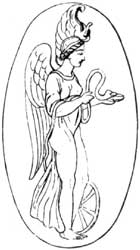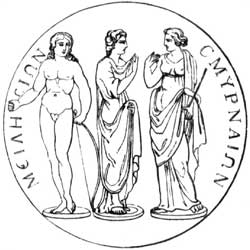Nemesis

"Dispenser of Dues, Indignation." Nemesis is most commonly described as a daughter of Nyx (Night), though some call her a daughter of Erebus1 or of Oceanus.2

Nemesis is a personification of the moral reverence for law, of the natural fear of committing a culpable action, and hence of conscience, and for this reason she is mentioned along with Aidos (Αἰδώς), i.e. Shame.3 In later writers, as Herodotus and Pindar, Nemesis is a kind of fatal divinity, for she directs human affairs in such a manner as to restore the right proportions or equilibrium wherever it has been disturbed; she measures out happiness and unhappiness, and he who is blessed with too many or too frequent gifts of fortune, is visited by her with losses and sufferings, in order that he may become humble, and feel that there are bounds beyond which human happiness cannot proceed with safety. This notion arose from a belief that the gods were envious of excessive human happiness.4 Nemesis was thus a check upon extravagant favors conferred upon man by Tyche or Fortuna, and from this idea lastly arose that of her being an avenging and punishing power of fate, who, like Dike and the Erinyes, sooner or later overtakes the reckless sinner.5
The inhabitants of Smyrna worshiped two Nemeses, both of whom were daughters of Night.6 She is frequently mentioned under the surnames Adrasteia and Rhamnusia or Rhamnusis, the latter of which she derived from the town of Rhamnus in Attica, where she had a celebrated sanctuary.7 Besides the places already mentioned she was worshiped at Patrae8 and at Cyzicus.9
❧
Iconography
Nemesis was usually represented in works of art as a virgin divinity, and in the more ancient works she seems to have resembled Aphrodite whereas in the later ones she was more grave and serious, and had numerous attributes. But there is an allegorical tradition that Zeus begot by Nemesis at Rhamnus an egg, which Leda found, and from which Helen and the Dioscuri sprang, whence Helen herself is called Rhamnusis.10 On the pedestal of the Rhamnusian Nemesis, Leda was represented leading Helen to Nemesis.11 Respecting the resemblance between her statue and that of Aphrodite, see Pliny.12
The Rhamnusian statue bore in its left hand a branch of an apple tree, in its right hand a patera, and on its head a crown, adorned with stags and an image of victory. It was said to have been of colossal size and created by Agoracritus of Paros, a student of Phidias.
Nemesis sometimes she appears in a pensive standing attitude or with a stern facade, holding in her left hand a bridle or a branch of an ash tree, and in her right a wheel, with a sword or a scourge. Her attributes are similar to those of Tyche (Fortuna), such as the rudder. A statue of her was located at her temple at Rhamnus.
References
Notes
- Hyginus. Fabulae: Preface.
- Tzetzes on Lycophron, 88; Pausanias. Description of Greece i, 33.3; vii, 5.1.
- Hesiod. Theogony, 223; Works and Days, 183.
- Herodotus. Histories i, 34; iii, 40; Pindar. Olympian Odes viii, in fin.; Pythian Odes x, 67.
- Apollonius Rhodius. Argonautica iv, 1043; Sophocles. Philoctetes, 518; Euripides. Orestes, 1362; Catullus, 50, in fin.; Orphic Hymn 60.
- Pausanias. Description of Greece vii, 5.1.
- ibid. i, 33.2.
- ibid. vii, 20, in fin.
- Strabo. Geography, 588.
- Callimachus. Hymn to Artemis, 232; Pausanias. Description of Greece i, 33.7.
- Pausanias, l.c.
- Pliny the Elder. Naturalis Historia xxxvi, 4; comp. Pausanias. Description of Greece i, 33.2; Strabo. Geography, 396, 399.
Sources
- Aken, Dr. A.R.A. van. (1961). Elseviers Mythologische Encyclopedie. Amsterdam: Elsevier.
- Smith, William. (1870). Dictionary of Greek and Roman Biography and Mythology. London: Taylor, Walton, and Maberly.
This article incorporates text from Dictionary of Greek and Roman Biography and Mythology (1870) by William Smith, which is in the public domain.